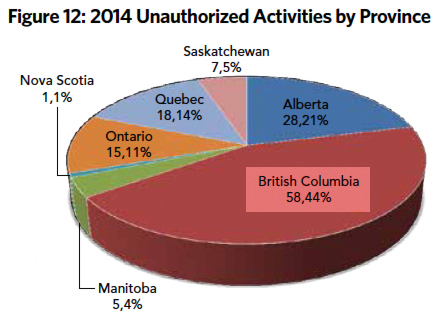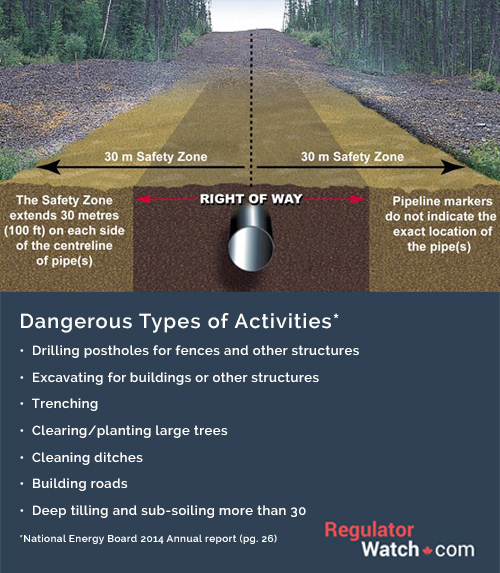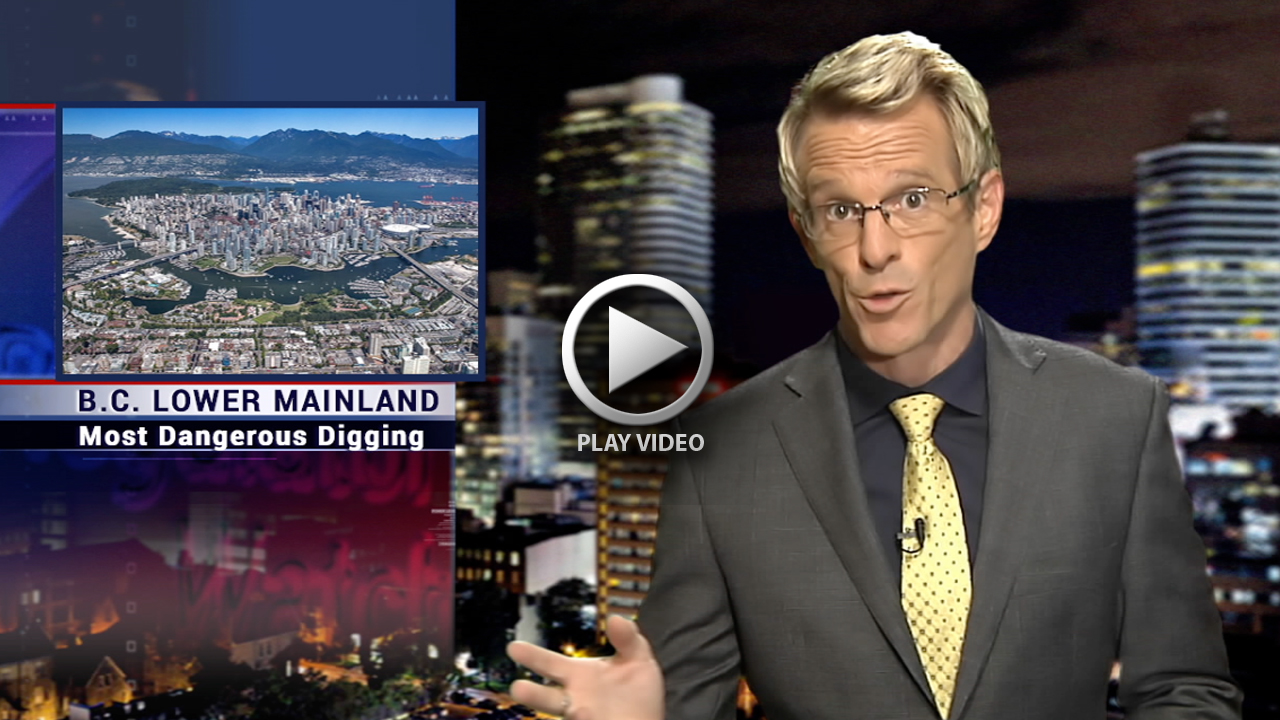The National Energy Board says in its newly released annual report that contractors, municipalities and landowners in BC accounted for 58 per cent of all incidents of ‘unauthorized activity’ around NEB-regulated pipelines in Canada in 2014. The most common hazardous activity according to the NEB is disturbing the ground — digging — near an underground utility without consulting the owner first. Most incidents occur in BC’s population centre, the Lower Mainland.

The NEB’s data comes from pipeline operators, who are required by the regulator to make a report each time someone carries out unauthorized activity within the rights of way of their pipelines. In BC, the regulator blames members of the “ground disturbance community” who fail to call pipeline owners before commencing a project.
The NEB notes that in BC, “provincial regulations for distribution of gas and electricity in BC do not require companies to physically mark their facilities, fostering a culture where many excavators do not call/click before they dig.”
Consequences of hitting a pipeline can be significant. For example in 2007 a contractor working for the city of Burnaby struck an excavator shovel into the Trans Mountain oil pipeline five times after failing to fully consult Kinder Morgan Canada about excavation work in the pipeline’s right of way, setting off a 224,00 litre spill along Inlet Drive and through storm drains into Burrard Inlet.

Recent news reports suggest that local governments find it inconvenient to call before carrying out some types of excavation work in pipeline rights of way. For example, a lawyer representing the City of Surrey told 24 Hours Vancouver in March 2015 that the city did not believe it was necessary for road repair crews to consult Kinder Morgan before fixing potholes along the Trans Mountain Pipeline right of way. The city wants the NEB to change its regulations, giving local government discretion to carry out “routine” ground disturbance activity in the right of way without notifying the owner.
NEB regulations currently provide no room for excavators to decide for themselves whether or not an activity could result in a disaster. They require excavators to get written permission from the owner prior to excavation and construction within the 30-metre safety zone for NEB-regulated pipelines, three days’ notice before digging, and hand-digging-only within three metres of a pipe.
In spite of those regulations, and BC One Call’s ongoing Call or Click Before You Dig public education campaign, the NEB report indicates that excavators regularly ignore the rules.
“Ground disturbance is the most hazardous UA, and it is also the most consistently reported,” the NEB reported.
 The regulator reported 132 unauthorized activities, or UAs in 2014 compared to 113 in 2013. BC let with 58 per cent of those incidents, followed by Alberta (28 per cent), Quebec (18 per cent) and Ontario (15 per cent).
The regulator reported 132 unauthorized activities, or UAs in 2014 compared to 113 in 2013. BC let with 58 per cent of those incidents, followed by Alberta (28 per cent), Quebec (18 per cent) and Ontario (15 per cent).
According to the report, while the majority of UA violators are contractors who are professional excavators, UAs by municipalities, which include Provincial entities such as Ministries of Transportation, are on the increase.
An unauthorized activity is described by the Board as a “near miss” incident. The regulator maintains a record of these incidents in order to calculate risk factors around underground infrastructure and focus its damage prevention messages where they’re most needed “and to affect change in at-risk behavior.”
“Our outreach and engagement activities and damage prevention public education material focuses on safe excavation and how to live and work safely near pipelines,” the NEB says in the report.
An increase in the number of UAs isn’t necessarily bad news, however, according to the regulator.
“The increased number of reports shows that there is not necessarily more UAs occurring, but rather that there is better awareness of the reporting requirements of National Energy Board Pipeline Crossing Regulations, Part II (PCR II).”
That suggests Kinder Morgan Canada is more vigilant about monitoring the Trans Mountain pipeline, and reporting violations the NEB, compared to pipeline operators in other provinces.

The report also indicates that the regulator is stepping up its scrutiny of the companies it regulates. It conducted 353 compliance verification activities “related to security, public safety and environmental protection” in 2014 compared to 303 in 2013. It issued 302 notices of non-compliance and carried out audits of six of the companies it regulates.
The NEB regulates over 115,000 kilometres of underground transmission pipelines across Canada. The NEB regulates any line that crosses a provincial or international border. Other lines are regulated provincially.
Scott Simpson – RegulatorWatch.com – June 15, 2015
Scott Simpson is a Sr. Writer & Analyst for RegulatorWatch.com
He is a Metro Vancouver communications consultant, working with clients in the energy, resource and public policy sectors. Previously, Scott spent 32 years as an award-winning reporter, columnist and editor at the Vancouver Sun, including a 10-year stint as a business reporter where led provincial coverage of regulatory affairs.









